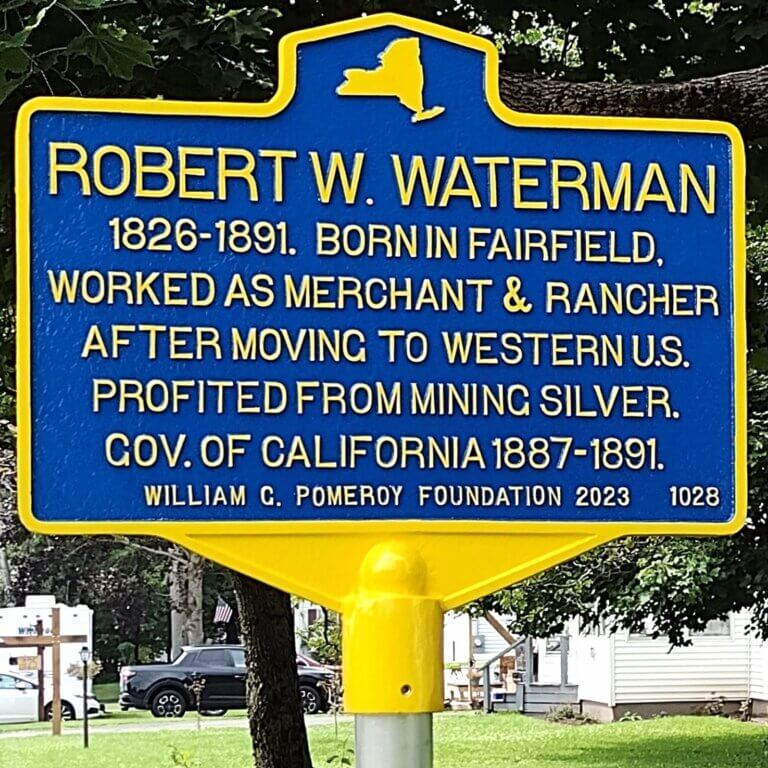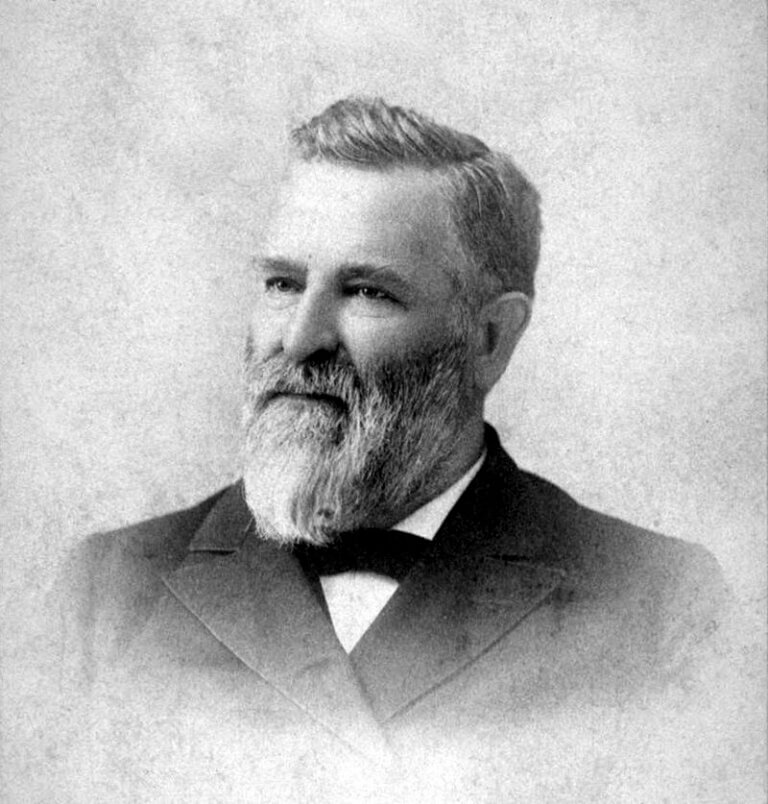- Program
- Subject
- Location
- Lat/Long
- Grant Recipient
-
NYS Historic
-
Government, Industry & Commerce, People
- 125 Academy Walk, Middleville, NY 13406, USA
- 43.138491771031, -74.913731343038
-
Fairfield Restorations Association, Inc.
ROBERT W. WATERMAN
Inscription
ROBERT W. WATERMAN1826-1891. BORN IN FAIRFIELD,
WORKED AS MERCHANT & RANCHER
AFTER MOVING TO WESTERN U.S.
PROFITED IN MINING SILVER.
GOV. OF CALIFORNIA 1887-1891.
WILLIAM G. POMEROY FOUNDATION 2023
Who was Robert W. Waterman?
Quintessential self-made success story who staked out west in search of fortune at a young age?
Ruthless tyrant who sought to leverage other’s misfortunes for his own personal gain?
Honest Miner?
“A picture of vile hypocrisy”?[1]
Well, if you were around in 1886, the answer to that original question would likely and largely depend on what newspaper you read, seeing as this was the year Robert Waterman became a candidate for Lieutenant Governor of California. Hence, many sought to answer that question based on their political affiliation, which led to some particularly value-charged and attention-grabbing headlines—especially in California.
But Waterman’s story doesn’t start in California.
Born in Fairfield, New York on December 15th, 1826, Waterman started the journey which would eventually lead to his gubernatorial appointment from humble beginnings. His father, John Waterman, operated a hotel in the Town of Fairfield, the site of which was located on the corner of Academy Walk and Hard Scrabble Road where the historic marker now stands. Though the hotel was replaced by barracks for the nearby academy during the late 19th-century, which in turn was replaced by a private residence in the early 20th century, Waterman’s early formative years were spent in Fairfield.
That changed, however, with the death of his father in 1837. Shortly after, somewhere between the ages of 13-15 according to most secondary sources, Robert embarked on a journey to Illinois to join his brothers. Here, he would work as a store clerk and live with his brothers in a familiar establishment: a hotel. “The Nunnery,” as it was called, hosted several boarders including the Watermans. Of these young boarders, an early 1868 publication written by Henry L. Boies, History of Dekalb County Illinois, recounts, “as full of pranks and fun, and practical jokes, as ever a dozen wild fellows could have been.” (P. 387).
While in Illinois Waterman married Jane Gardner and eventually opened his own store. In the 1850 federal census Waterman is listed as a “merchant” living with Jane and their two children.
Around this time Waterman became involved in two ventures that would define his later years: mining in California and politics. In the early 1850s Waterman set out on his first mining trip to California to little success, spurring him to return to Illinois where he worked as a storekeeper and owner of a newspaper. Shortly after that, he would find himself as early member of the emerging Republican party—a political affiliation he would hold for the next nearly forty years. Later sources credit Robert W. Waterman with several successes for the new party: ranging from serving as an early delegate to the national convention to helping Lincoln achieve the party’s support in the famous 1860 campaign.
Waterman’s stalwart support proved crucial to his eventual political career; however, this was still years down the road. Waterman managed his business ventures in Illinois for several years, before once again setting off for California. This trip proved defining to his legacy.
While in California, the future Governor set about establishing a series of silver mines through rapid acquisition. In the early 1870s Waterman possessed a small ranch near the San Bernadino Mountain, nearby, he established seventeen silver mining claims, according to his biography on the “Governors Gallery” of the California State Library (Access HERE). One of the most lucrative under his ownership was the Barstow silver mine, and much of his success occurred in the Calico Mining District.
This sudden wealth was not without its controversies: a legal dispute with his brother’s widow over a mine proved easy fodder for those attacking the aspiring politician, as did another dispute over ownership of yet another mine with the family of a murdered miner who claimed rights to said mine. The latter sparked headlines such as “The mysterious murder that Enriched R. W. Waterman,” which appeared in the October 22nd, 1886 edition of the San Francisco Daily Examiner.
The negative press did not prevent him from quickly ascending the ranks in his party, and in 1886 he was nominated for Lieutenant Governor, then elected. His nomination marked the first time in California history that the Governor and Lieutenant Governor were from opposing party, as Governor Washington Bartlett was a member of the Democratic party. Shortly after both men were elected Bartlett passed away from a kidney disease, and Waterman was appointed Governor of California.
As Governor, Waterman faced several important issues: the decision on whether to split the state in two and excessive government spending at the state level being two of the most pressing. As Governor, Waterman would support the creation of Yosemite National Park, and, after taking inventory of the prisons in California, grant a number of pardons for individuals he felt were wrongly convicted.
Waterman left office in 1891 on account to poor health. He returned briefly to his many business ventures; however, the same year he retired from politics he would also pass away.
Though a controversial figure at times, Waterman’s success as a businessman, miner, rancher, and politician were impressive. And, to answer the questions originally posed: strangely, despite such an interesting life, as of 2023, few publications related to Robert W. Waterman have been produced.
Hopefully, an in-depth review of his life is on the horizon. In the meantime, his career and connection to Fairfield, New York are now spotlighted with a historical marker.
[1] The San Francisco Examiner, Sep. 23, 1886.


